If you list the symptoms of cervical osteochondrosis - almost every adult will say he feels them.The disease really has a significant prevalence: in developed countries, osteochondrosis occurs in 60-80% of the population.In order to distinguish whether a person is true -actually has cervical osteochondrosis or different country manifestations, it is necessary to have information about this pathology.This article describes the cause of the disease, characteristics and manifestations, methods of diagnosis and treatment.Having information on pathology, patients will be able to identify them at home and seek timely help.
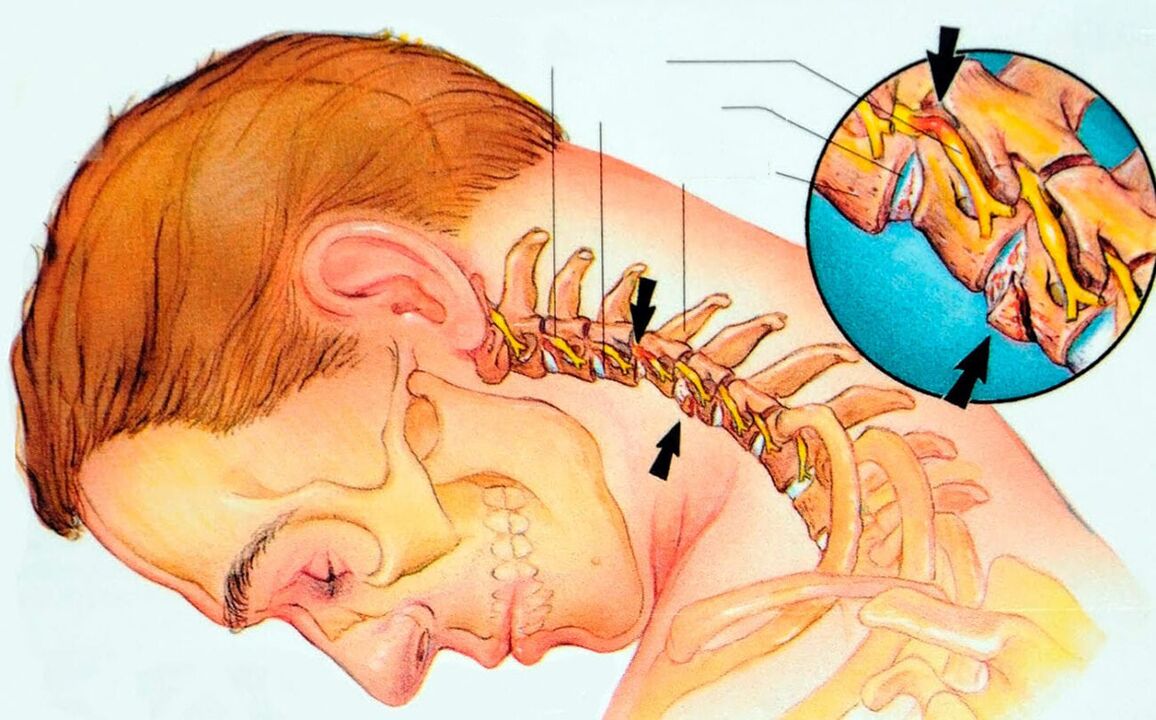
What is cervical osteochondrosis?
The disease is degenerative and damages the spinal structure with primary and secondary mechanisms.The pathological pathogenetic mechanism is that the vertebral connection structure is damaged.
Usually, among these areas is a layer of pulpoose fabric.It shrinks the spine and optimizes the motor process.With cervical osteochondrosis, this soft material is calcified and turns into hard tissue.This damages the ending of the nerves and blood vessels, violating their function.
Depending on the degree of damage, osteochondrosis can be characterized by pain or high pressure, impaired consciousness or numbness.It can be a symptom of the chest or back.This greatly complicates the diagnostic process.Patients can pass some diagnostic consultations before they have a profile specialist.The diagnosis process uses several methods that allow the pathology of the organs and other systems.
Gradually, cervical osteochondrosis is "younger" and is increasingly found in young patients.Modern young people are beginning to have problems with their necks much earlier than their parents.
Osteochondrosis is a deterioration of the cervical region, which is common to consider from two positions:
- Physiological changes.In fact, the deterioration of the cartilage is a natural part of the development, controlled by the mechanism of -Dococrine neuro and irreversible.This process begins with the center of the pulpic layer and gradually passes to the edge.Soft tissue is replaced by fibrous elements.Such a process practically does not interfere with the patient and manifests itself only when it affects the nerve endings.
- Pathological change.The destruction of the vertebrae due to the effect of a set of factors.This process is ahead of physiological changes and leads to a violation of spinal function.Symptoms accompany this condition almost always, as they spread outside the cartilage structure and damage the nerve endings, blood vessels.
The course of the disease can be a different properties: sometimes the pathology is freely compensated or vice versa - there is a better period.At the same time as the pathological process, the compensation mechanism is included, which temporarily expands the function of the vertebra and eliminates the symptoms.
However, the next journey of the disease leads to the destruction of fibrous rings, the appearance of microcucco.The vertebra loses its stability and setting, which is characterized by the clinical picture of the disease.
In addition, cervical osteochondrosis is an intervertebral space pulp impregnation with calcium.This forms a hernia, as the damaged vertebra is pressed into a nearby body.The structure is weary and as a result there is a large ossification -a neighboring structure.
Cervical osteochondrosis courses have several stages:
- Level 1 is the instability of the vertebral structure and disk violation;
- 2 stages - reduced spine fixation and disc promotion;
- Stage 3 - rupture of fibrous rings, severe symptoms and pain;
- The 4th level is accompanied by difficulty in movement, acute pain and widespread bone spread.
Characteristics of muscle and blood vessels anatomy - make the neck an exposed area of the body.Long osteochondrosis courses lead to many complications, including vascular properties.Many of them can cause significant harm to the patient's health and create a clear risk.
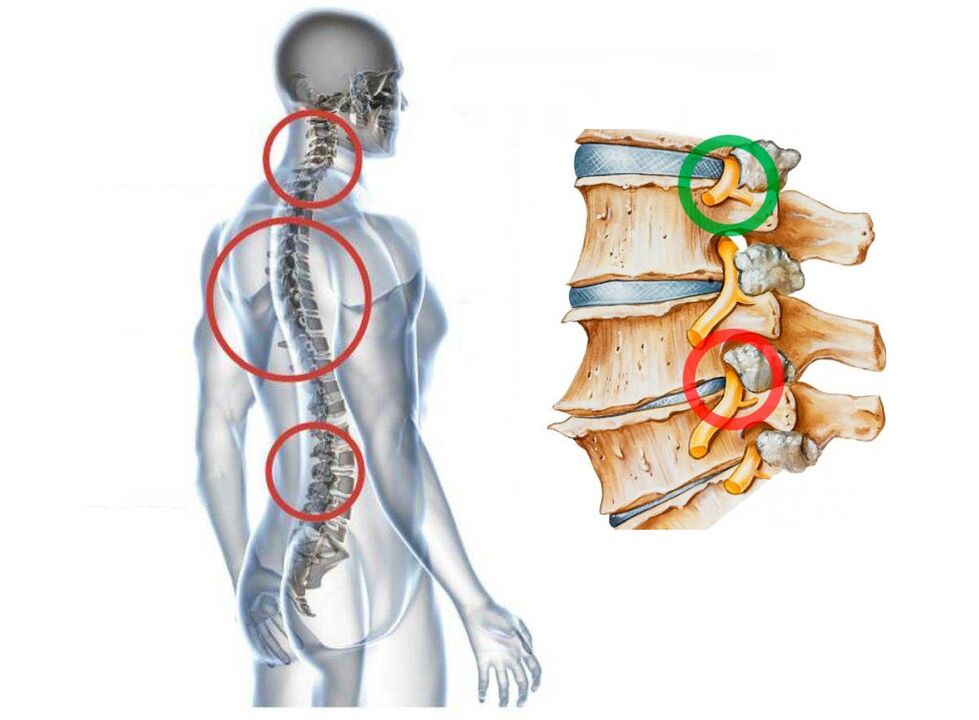
Symptom
The danger of cervical osteochondrosis is that it is not indicated by symptoms for a long time.This is facilitated by the protector of the disease signs for other pathologies, as well as the administration of analgesic drugs.This makes the diagnosis of cervical osteochondrosis long and difficult.It is important not to slow down the diagnosis until the vertebral structure has been replaced by bone tissue.
Consider the major groups of symptoms found in cervical area osteochondrosis and their features.
Dizzy
As mentioned above, most symptoms of osteochondrosis can be a feature of other conditions.Therefore, dizziness is accompanied by vascular pathology of the central nervous system, damage to the hearing, vestibular apparatus damage, and cardiovascular disease.Dizziness is accompanied by intoxication, inflammation.It is important to take into account holistic clinical pictures, and not the individual symptoms.Also, one has to learn to distinguish between the main types of dizziness for the reason.
With cervical spinal osteochondrosis, a systematic type of dizziness occurs.It seems that the patient is that the surrounding object starts to move.Such disorders can be observed after head and neck injuries, as well as against the background of vestibular apparatus.
Headache
Again, it is very difficult to call these symptoms specific.Headache can accompany hard work, increased stress, and serious acute conditions.With osteochondrosis, headache occurs due to compression of the nerve endings.This leads to arterial spasming that sows brain blood, as well as increases pressure in the central nervous system.The result is a feeling of headache.
The features of the headache in this case are a boring character and a pulse.Sometimes the pain can be cleared by the attack, and sometimes it has a regular character.The pain parameters for osteochondrosis resemble these features with hypertension, angina pectoris.The difference in headache in cardiological pathology is that it is accompanied by chest pain, heart rhythm, changes in ECG.Therefore, only a doctor can finally determine the cause of the pain.
Disappointed Disease Syndrome
In addition to headaches, patients often worry about neck pain.This is called cervix and complications of osteochondrosis.Painful sensations can emit the top.Patients noted that pain in their hands occurred after the resurrection, against the background of the movement.The painful sensation passes through their own after a short break.
Features -Features of pain syndrome with cervical osteochondrosis are listed below:
- Unpleasant sensations are located in the tissue in the neck;
- Head turns are often accompanied by pain and crisis;
- There is muscle weakness, numbness, hand cooling.
Often, neck osteochondrosis affects two lower vertebrae - 6 and 7. For yourself - Diagnosis, this method is recommended.It is necessary to pay attention to the combination of pain in the neck and fingers.Often, if the 6th vertebrae is affected by the thumb, and the change in the 7th vertebra is accompanied by discomfort in the middle finger.
Changes in blood pressure
Such symptoms arise when the nerve endings and blood vessels are affected by the vertebral changes.How to distinguish this phenomenon from hypertension?First of all, hypertension for cervical osteochondrosis is irregular and has its own jump in a day.
Osteochondrosis consists of the following syndrome:
- Vertebral.It is also called vertebrae, which indicates that bone and cartilage tissue are involved in the pathological process.This leads to the formation of such symptoms: restrictions on neck motor activity, pain in turn, radiological changes in cervical spine images.It is a simultaneous appearance of these signs that are vertebral syndrome.
- Vertebral artery syndrome.It seems when the vascular beam is involved in the process, which is responsible for the blood supply to the central nervous system.Symptoms indicate that brain tissue no longer receives the right amount of nutrients.How to recognize this syndrome?The first signs are dizziness, sound in the ear, blood pressure difference, "lid" appearance in front of the eyes.This indicates that one of the vertebrates is in a striked state.Each ship has its own nerve endings.If you squeeze people who spread the vertebral artery - migraine, numbness, short decrease in vision in one hand will appear.As a result, changes in vessels lead to the fact that the brain requires oxygen.Currently, one experience drowsiness, short consciousness violations, loss of attention and control, works worse and remembering information.With such a clinical picture, it is necessary to distinguish cervical osteochondrosis with atherosclerosis of the vertebral artery, and squeeze the tumor or inflammation.
- Cardial Syndrome.It is indicated by burning in the chest area, the appearance of shortness of breath.A person feels his frequent heartbeat, tired and irritable.This picture is also a feature of cardiological pathology, for example, for angina pectoris, coronary syndrome, heart attack.Accurate conclusions about the cause of such symptoms can be made after the patient passes through the ECG.
- Rook Syndrome.The cervical department absorbs 8 pairs of nerves, each has roots - nerves out of the vertebra.When they are involved in osteochondrosis, the patient feels a decrease in sensitivity or vice versa - severe pain.There may be numbness in the pain, decreased tongue sensitivity, freezing area, pain in the Supraclinking region can be observed.Sometimes there are swallowing disorders, movements in the upper belt, finger numbness.
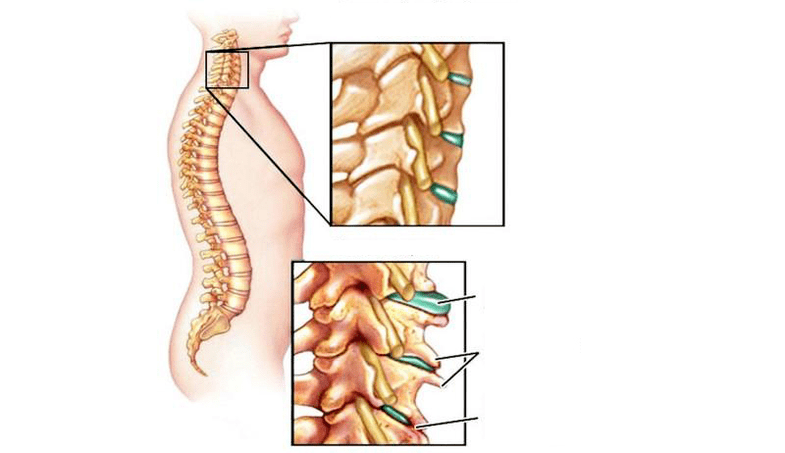
The cause of cervical osteochondrosis
The main cause of the development of osteochondrosis is the unnatural distribution of loads in the spinal column.The reason can be different - one can wear a bag or weight on the one hand, taking the wrong pose when he sits or sleeps on an uneven surface.It increases high loads and pillows and shoes that do not fit the leg anatomy features.The causes may seem not important, but they act for a long time and, as a result, lead to logical consequences in the form of osteochondrosis.
Some of the risk factors that increase the likelihood of illness:
- low levels of physical activity;
- weight gain;
- spinal injury sent;
- violations of posture or foot pathology;
- Reduces blood supply to the cervical spine.
All of this leads to the fact that the wrong position of the vertebra is formed.Weight is not distributed to all parts of the cervical region evenly and some of its departments carry heavy loads.The response is a change in tissue.
To one degree or another, the situation can be aggravated:
- Suffering from serious illness or injuries that cause a good health;
- Frequent stress;
- Violation of metabolism in the body, reducing the use of trace elements, increasing use or lack of absorption in the intestine;
- Occupational diseases (in particular, vibration disease);
- Descent tendency for osteochondrosis;
- Scoliosis and other disorders of the musculoskeletal system;
- Drinking regime violations;
- Low nutrition and bad habits;
- Pregnancy.
As you can see, not just the cause of osteochondrosis.There is only one set of factors that can trigger it.Again, the same reason affects different people in different ways.Health conditions, duration, intensity and number of risk factors, background pathology, and lifestyle play a role.
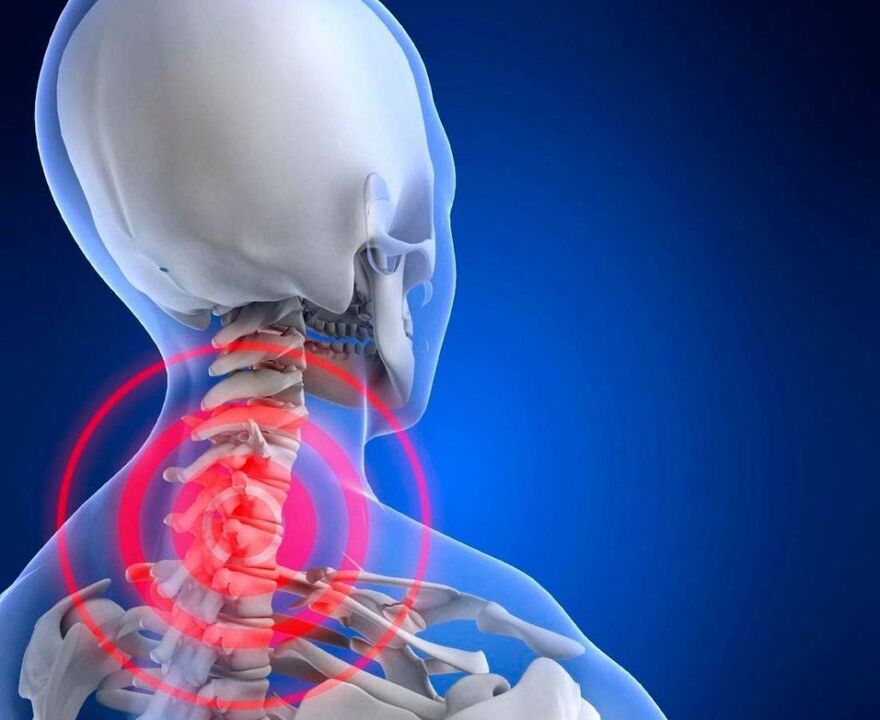
A modern method of treatment
Even before the therapy prescription, the patient must change the way of life.For this, it is necessary to change the level of load experienced by the cervical department.It is necessary to monitor the quality of nutrition, to spend the time it takes to sleep and rest, to be careful with stress.If the body has a background pathology that exacerbates osteochondrosis, it is necessary to undergo treatment and eliminate it.The choice of treatment method depends on the level of osteochondrosis and the well -being of the patient.
Treatment can be:
- not -Drug;
- medicine;
- Surgery.
Separately consider folk methods and recovery measures.
Non -Drug treatment methods consist of the use of therapeutic exercises, simulators or special devices, manual therapy, and physiotherapy methods.The right purpose is facilitated by increasing blood supply in the vertebra or slowing down the ossification process.
For manual or massage therapy, be sure to consult your doctor about their suitability.Do not give yourself this method independently.At some stages of osteochondrosis, massage can only be harmful and lead to long immobilization.If manual therapy is performed according to the guidance, it can relieve the symptoms and improve the well -being of the patient.
From physiotherapy techniques, with cervical osteochondrosis, the following are used:
- magnetotherapy;
- Therapeutic baths;
- Therapeutic baths;
- mud;
- Electrophoresis.
The use of drugs is indicated in terms of severity.Most of them eliminate inflammation and sharp pain, increase blood supply to tissues, restore cartilage structure, and ensure joint mobility.This is a comprehensive approach to causes and symptoms, and not unilateral solutions to this problem.After taking the properly selected medication, the patient again has the opportunity to move his neck, stop having irritation, worsening mood, returning to normal work and sleeping.
Consider a group of drugs used for cervical osteochondrosis:
Anti -Nonsteroidal Anti -Medicine
They are used to reduce the phenomenon of inflammation in the tissue, relieve pain, relieve roots and blood vessels.With small symptoms, ointment and gel are used, more intense pain syndrome is stopped by tablet form.The injection administration is prescribed with severe pain intensity and sharp occurrence.
They can have another trade name, but the active ingredient remains unchanged.Patients should take medications with this course, only after approval of the attending physician.Please note that these funds must be taken after meals, as they can irritate the mucous membranes of the gastrointestinal tract.
Vasodilators
Their function is the development of vessels that narrow down the background of osteochondrosis.Drugs - pentoxifillin, actovegin, berlithion.These drugs will relieve vertebral artery syndrome, increase blood flow to the vertebra and the well -being of the patient.It is necessary to monitor the lack of contraindications to these substances in patients, as well as their compatibility with other medications taken by a person.
Muscle relaxants
The purpose of this group is a decrease in neck muscle cramps.This accelerates and optimizes the treatment process, as muscle tension acts on vessels and nerve endings.Normal intake normalizes blood vessels, reduces pain.
Chondroprotectors
Take to improve the condition of the spinal cord and protect their structure from destruction.Long acceptance of these materials is required, otherwise they will not have the right action.Patients may not like the effect only after 6 months of use.However, if this effect is achieved, it will continue and increase the clinical picture.
Sedative
They are used as additives to eliminate manifestations and pressure of depression.In light cases, valerian, motherwort, mint and lemon balm are used.If depression is ongoing, more serious materials are needed.They will increase sleep and mood, helping patients for effective treatment.
Vitamin
Acceptance of vitamin B. They can be recommended from foods - this road introduces vitamins is the most physiological and does not carry a special burden on the liver.If vitamin deficiency is observed, vitamin and drug complexes can be used.This will increase sensitivity and conservation, accelerating the tissue recovery process.
Because the process of treatment is prolonged and gradually has the effect, all stages of taking the drug are important.Make sure the medicine is stored in the right place, as shown in the package.If in the box it is written that you need to keep the medicine in a dark or cold place - do, otherwise the drug will lose its properties.Note the duration of the course and the frequency of applications - some materials tend to accumulate in the body, and only have the right effect.
If the introduction path is injected, the procedure should be performed by a medical staff or trained person, as proper identification improves efficiency.The shape of the tabblet must be taken after meals, washed with water.Note this time, because other fluids are not suitable for this.The combination of grapefruit juice and medicine is very dangerous - the enzymes contained in this fruit slow the function of the liver and reduce the delivery of drugs to the tissues.
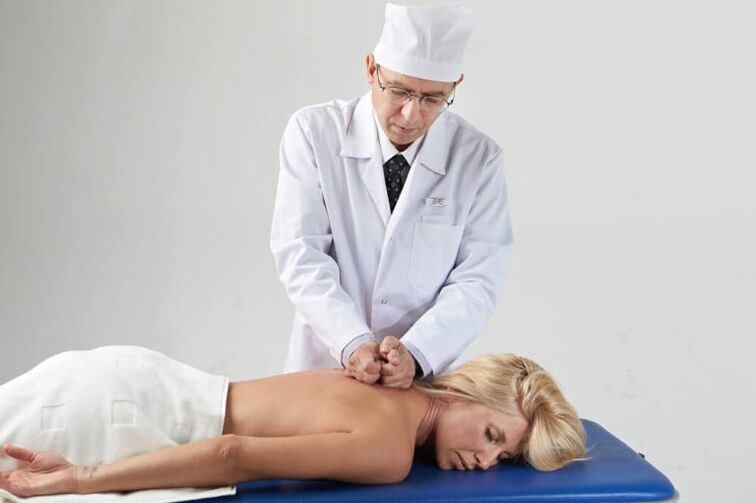
Treatment of cervical osteochondrosis surgery
This method is used when cervical osteochondrosis leads to narrowing of the spinal column lumen.This can be the result of a hernia or disk prominent.The narrowing of the channel is accompanied by significant stenosis of the vessel and compression of the nerve beam.If an intervertebral disc isolated hernia is observed, this is also an indication of surgical intervention.This operation is required for spondylolistz - a vertebral displacement of the axis.In addition to these signs, doctors pay attention to the quality of life of the patient, his condition, the severity of the symptoms.
Type of surgical intervention:
- Supported spondylododeza.The essence is to remove the damaged disc and replace it with a moving connection, the prosthesis that performs isolated structure function;
- Dynamic stabilization of the spine.Silicone implants are introduced between the process of rotating along the spine, which properly distributes the load and stabilizes the vertebra;
- Disk nucleus vaporization with laser beam.This is a modern technique that shows good results.Laser affects the core of the disc, reduces its size and eliminates the hernia.The intervention is atravmatic, it can be carried out under local anesthesia.However, a set of indicators for such manipulation is limited, it can only be done at that stage.When the hernia size does not exceed 6 mm.This again focuses on why you are looking for a doctor and a timely diagnosis.
Surgical intervention was held at the hospital.Depending on the level of complexity of the treatment, the period of postoperative and recovery is different.Handling surgical intervention implies complex additional drugs - medications for patient preparation, analgesics, antibacterial therapy for the prevention of septic complications.
Diagnostics
The onset of diagnosis is the beginning of the patient's address to the doctor and the listing of symptoms.Doctors hear patients' complaints, detail them, forming them from the symptoms of the syndrome.Also, experts need details on clinical manifestations: the time of occurrence, whether the treatment method is used and what the influence, the nature of the pain, the increased period of stress and more widely used.In important information is information on uncomfortable positions during sleep, work, bad habits, background disease.All of this is clear during the conversation.
X -ray is done in direct and lateral projections.Radiological studies are performed simultaneously with neck rotation.Instead, the spinal cord is used to visualize the affected area.Instead, it can be introduced into the ship or the disc itself, depending on the method called angiography or discography.In the picture, you can see tissue seals, calcification deposits, spinal structure displacement.
For magnetic resonance tomography, this is the most informative method, which is also painless and fast.Doctors can see damage and cause severity.Tomographic scans will help the surgeon be prepared for surgery, determine the hernia, changes in the nerve endings and blood vessels.
MRI is carried out without contraindications that are metal objects in the body, congestion.Pregnancy.
The computed tomography also provides an accurate diagnostic picture.This study does not take much time - about 10 minutes and does not require special preparation.The radiation burden in this study is small, which makes tomography safe for health.Contraindications - pregnancy and lactation, children's age.
In addition to methods that allow you to visualize the pathological process, it is necessary to use additional diagnostic manipulation.
This includes the ultrasound study of the head and neck vessels.Indications for diagnosis are dizziness, headache, stress drops.The specialist will determine the patency of the blood vessels and the condition of the blood flow.The most informative method, in this case, is the duplex scanning of the blood vessels.
Prevention
As you can see, cervical osteochondrosis has a variety of clinics, many syndrome and requires a serious approach to diagnosis and treatment.If you pay attention to your sensation, listen to the body and respond to the signal, the initial diagnosis is possible.In the first stage of the disease - treatment has a high effect.
To do this, contact a profile specialist and through the necessary research methods.High and timely treatment will avoid complications, improve well -being and quality of life, eliminate depression and normalize sleep.Tune in a positive way and you can once again feel the freedom of moving.





































